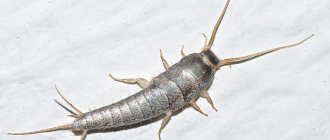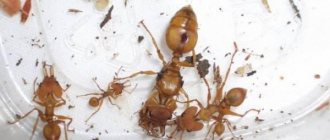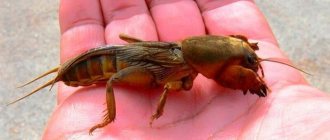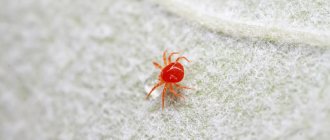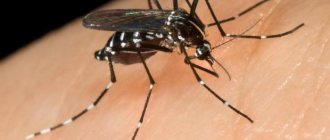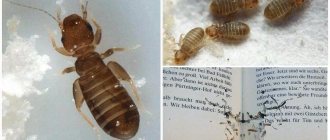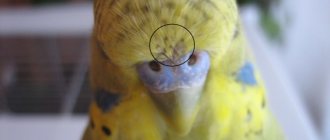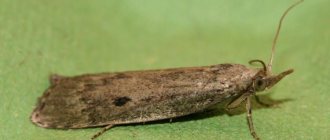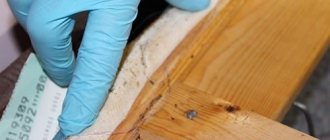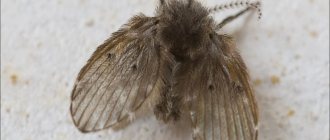The silverfish (Lepisma saccharina) is a wingless arthropod insect from the bristletail order, whose ancestors existed millions of years ago. The common silverfish is also called the sugar silverfish and silverfish because of its silvery-metallic color. And translated from English, silverfish are called “silver fish.”
Silverfish prefer to live in dark and damp rooms - a bathroom, bathhouse, basement, attic or garage. These insects tend to hide from people, so the apartment dweller may not immediately understand that there are “living creatures” in his bathroom.
Description of the appearance of silverfish
The silverfish has no wings, but can run very fast. Adult silverfish have a body length of about 12-19 mm, not including the tail. They have a flat, teardrop-shaped body that tapers from the head to the back and is usually covered in scales. There are three long processes on the tail. They also have thread-like antennae and small, wide-set eyes.
Immature silverfish are similar to adults except for size and color (they are smaller and white), and their scales appear during their third or fourth molt.
Features and lifestyle
Silverfish move quickly and climb vertical surfaces well. They can live for several weeks without food or water, but they require high humidity of 70 to 90 percent to live comfortably. Silverfish prefers places with room temperature (21-29 degrees C). They are nocturnal and prefer to hide or rest in narrow cracks or crevices during the day. Silverstone can be found almost anywhere in the home, including living rooms, bedrooms, bathrooms, attics, basements and garages.
Silverfish thrive in shops, libraries and offices. They often enter commercial premises through cardboard boxes containing books and papers from contaminated areas. They will travel quite a distance in search of food, but once they find a suitable food source, they will stay close to it. Indoors, they can breed in a variety of areas including wall voids, inside/under subfloors, attics, etc.
Insect control products
If there are pests in the house, do not rush to call the sanitary and epidemiological station.
These insects have been living next to people for thousands of years, so many means have been invented to combat silverfish in the apartment. If the infestation has become widespread, it is necessary to use special means to destroy pests. Traps help remove silverfish from your apartment. They are installed in places with the greatest concentration of silverfish, which are determined by the presence of black lumps, holes and stains on paper and fabric. Traps can be made in the following ways:
- A 1 liter jar is wrapped with electrical tape. Bait is placed inside, consisting of the pests’ favorite foods: bread, starch, sugar, pasta. Attracted by the smell of the bait, the insects fall inside the jar through the duct tape. They cannot get back out, as their paws slide along the smooth inside of the jar.
- An effective trap for silverfish is made from newspaper. It is rolled into a tube, tightened on both sides with rubber bands, moistened with water and left overnight in areas where pests live. They will like this kind of bait. Silverfish will climb into it and chew the paper. In the morning they can be destroyed along with the newspaper.
- Special traps for pests can be purchased at hardware stores.
If there are a large number of insects, it is necessary to install several similar traps at once. You can also get rid of silverfish in your apartment using the following home remedies to repel pests:
- Lemon or orange zest is grated and placed in areas infested with insects. Once a week the product is replaced with a fresh one.
- Sliced lemon is poured into a liter of water and left for 24 hours. The resulting solution is sprayed with a spray bottle where pests were noticed.
- Tincture of lavender or cloves works well to repel silverfish. To prepare it, dilute a few drops of lavender or clove oil in 100 milliliters of water, then treat kitchen furniture and floors with the resulting product.
- Silverfish cannot tolerate the smell of spices. To drive insects out of the kitchen, bags of bay leaves, cinnamon and sage are placed everywhere.
- Boric acid is diluted with water and the solution is coated with corners, shelves, and floors near baseboards.
Reproduction and lifespan
Before mating, the silverfish performs love dances. Males lay spermatophores, which take females into the ovipositor. The number of eggs and the habits of females vary depending on the species. The female sugar silverfish lays from one to three eggs per day (and the domestic thermobia can lay up to 40 eggs per day), placing them in cracks, under objects or leaving them unprotected in open space.
The development time of the larvae is three to four months under favorable conditions: 20–30 degrees and a relative humidity of at least 50–75 percent. Otherwise, it may take up to two to three years. Most silverfish live up to three years.
Newly hatched young silverfish, also known as nymphs, have a white body color. Nymphs emerge fully formed from the egg and undergo a series of moults to become full-fledged adults. As they age, the nymphs darken and acquire a silvery-brownish color.
A silverfish can produce more than 50 moults in its life, so in a room infested with these insects, fragments of their scales will certainly be found.
Finding even one nymph in your home can be a cause for concern. Regardless of age, the presence of one silverfish usually indicates that a full-scale infestation has already occurred in hidden areas of your home.
Hay beetles Psocoptera
Hide advertisements in article
Order SENOEEDS (Psocoptera) Senoyeds are very small insects, from 1 to 5 mm long, with thread-like antennae and a very peculiar head structure. The hay beetle is always easy to distinguish from other insects if you examine its head from the side. It is striking that between the highly developed convex clypeus and the upper lip, a peculiar skeletal formation is wedged in the form of a transverse strip - the clypeus, which is not found in any other order of insects. The oral apparatus of hay eaters is also characteristic. Their upper jaws are massive, typical of a gnawing mouthpart. In the lower jaws, a very strong change occurred: their internal lobe became isolated in the form of a long hard stick, protruding far into the skull, where it was immersed in a special dense sac. The outer end of the stick has small teeth. Rich muscles give great mobility to this organ, allowing it to be thrown forward, deviate sideways, rotate, etc. The stick serves as a tool with which the insect crushes food before eating. Hay beetles mainly feed on terrestrial green algae, lichens, as well as molds and parasitic fungi. Some of them feed on organic remains and plant dust, which is where the name of the order comes from. Less commonly, they eat living tissues of higher plants. Most hay beetles are winged insects: they have two pairs of membranous wings, which at rest are folded like a roof on the abdomen. The wings can be either colorless or with dark spots and bands; the second pair is always smaller than the front ones, with simplified venation. In a number of species, the wings are shortened or even completely absent. Seneaters exhibit sexual dimorphism, most often expressed in the fact that in males the antennae are more densely covered with hairs, and the eyes are greatly enlarged, almost spherical. In some winged species, females may be short-winged or wingless. The fact that hay beetles have adapted to feeding on small organisms - lichens, algae and fungi - has ensured their widespread distribution, especially in tropical and subtropical countries. Over 1,500 species of hay beetles are known, of which only about 60 live in Russia.
In nature, favorable conditions for the existence of hay beetles are created in forests, both deciduous and coniferous. Here they can be found on tree trunks and branches, as well as on leaves. Trunks and branches covered with lichens are especially attractive to them. Some species live in the forest floor, in dry grass and even under stones. Others are found in the nests of birds and insects. Most species of hay beetles have several generations per year, and eggs can often develop without fertilization. Females, using a small ovipositor, lay eggs either one at a time or in small groups on leaves, needles, and in bark cracks on trunks and branches. In some cases, egg clutches are covered on top with rectal secretions, which dry out and form small scales. In other cases, the masonry is covered with a light cobweb. The arachnoid thread is secreted in hay beetles by a special spinning apparatus, the duct of which lies in a groove formed by corresponding depressions on the lower lip and on the uvula covering it. This is the only time when insects produce webs from their mouths. Eggs laid in autumn overwinter. In the spring, they hatch into small larvae that resemble lice in appearance, which is why they are sometimes called “wood lice.” The larvae that hatch from the eggs either crawl to the sides and then lead a solitary lifestyle, or they remain in place and stay in small “bands”, creating a common web nest. The larvae molt several times and after each molt increase in size. In winged forms, after shedding the larval skin, the rudiments of the wings lengthen. Some hay beetles are found in residential buildings, libraries and museum premises. Some of them live in pots with house flowers and usually feed on plant debris. Others penetrate bookcases, herbariums and insect collections and in these cases can damage museum exhibits. In nature, it lives in bird nests, and in houses it is found in old papers and books. It can penetrate insect collections and herbariums and, if they are not well protected, causes noticeable damage to them.
Signs of silverfish
You can find silverfish in a bathroom or other damp room by turning on the light at night. The insects will immediately try to hide. In this they are similar to cockroaches.
If no live specimens are visible, but there are yellow spots, silvery scales, or tiny feces that look like fine black pepper, this indicates that silverfish have already taken up residence in your home.
Silverfish can easily climb walls and find entry around window and door frames, utility pipes and vents, foundation cracks, and holes in mosquito nets. Therefore, the insect could get into your apartment from neighbors, from the basement or from the street.
How to properly treat a room?
Proper cleaning of the premises is the key to successfully getting rid of insects. It is necessary to remove all remaining debris and seal cracks and holes, otherwise the parasites will return again. After thorough cleaning, you can begin treating floors and all surfaces. Whatever preparations you decide to use, they must be applied to places where insects accumulate, floors, remote corners and ventilation niches.
Insecticides can be removed from surfaces only after 48 hours. Home remedies take longer to work, so remove them later. Before treating the premises, you can collect insects with traps and Velcro for several days.
If silverfish attack an apartment building, independent control of parasites may be ineffective, since the insects will move from one apartment to another. In this case, you should contact a professional pest control service. Comprehensive measures will not only get rid of insects, but will also protect against repeated invasion for a long time.
Features of disinfection in the bathroom
Cleaning and disinfection in the bathroom should be carried out according to the following plan:
- Elimination of excess. Hygiene products are placed in a basin, a rug and towels are placed in the wash, and the curtain is soaked in a soapy solution.
- Washing tiles. Apply the detergent using a sponge to the dampened surface of the walls. An anti-mold spray can be used to clean tile joints.
- Pipe cleaning. A thick pipe cleaning gel is poured into the drain holes to remove dirt and blockages.
- Cleaning the toilet and bathtub. The cleaning agent is applied to the surface of the bathtub for a while and then washed off. Water is removed from the toilet, then the lid, walls and surface under the rim are washed. For disinfection, the product is left on the surface and then removed.
- Cleaning mirrors. Wash with detergent and wipe with a soft cloth.
- Washing the floor. The floor is washed with a disinfectant, then rinsed with clean water and wiped.
Note! For cleaning, you must choose products without abrasives.
Very often we just clean the bathroom, but forget about disinfection.
What harm do silverfish cause? Are they dangerous?
Silverfish do not bite humans, drink blood, or spread disease. But they can harm personal belongings, especially those made of paper. Sugarfish are known to infest items such as wallpaper, books, magazines and envelopes, so these materials can become damaged over time as a result of a silverfish infestation. They can also feed on glue and clothing, as well as foods such as oatmeal and flour.
Agree, it is unpleasant to find an insect in food or on your favorite books. Silverfish, like moths, can chew your clothes and upholstery.
In addition to material damage, silverfish can cause allergies in humans.
Silverfish also do not pose any harm to domestic animals; even if accidentally swallowed, they are not poisonous.
How to get rid of silverfish using a spray or concentrated insecticide?
Grand Insect Repellent
This is a universal insecticide concentrate. 230 ml of a pyrethroid-based chemical is enough for 150 liters of the finished substance. It can be used indoors, but this must be done with caution: the active ingredient is dangerous to humans, especially children. It is better to apply the product in protective clothing and in strict accordance with the instructions.
According to the product description, it is capable of killing almost all insects existing in the United States. The list of potential victims of Cyzmic CS takes up several paragraphs. It is especially good, according to buyers, against garden pests.
As for our little ones, buyers place Cyzmic above boric acid. They write that the sprays need to be re-sprayed from time to time. But usually “healing” occurs within a couple of weeks after the first application.
Dissatisfied comments were left by hornet fighters. The remaining 89% of buyers highly appreciated the benefits of the product.
Price: 1249 rub.
Preventing the appearance of silverfish
To prevent the appearance of silverfish in a house or apartment, you should monitor the humidity and try to dry the air in especially damp rooms. For example, it is better to leave the bathroom door open after a shower so that it can ventilate. If you live in a damp climate, you will have to purchase a dehumidifier and use an air conditioner or heater more often.
Repair leaking pipes and drains and remove or replace any moldy or damp wood in your home. Avoid storing old books and magazines in areas where silverfish are commonly found, such as basements, attics and garages. And it's important to store foods like flour and sugar in airtight containers.
To prevent silverfish from coming into your private home from the street, be sure to remove piles of fallen leaves, do not store firewood and building materials on the ground, remove vegetation along the foundation, and seal all cracks and crevices in the walls and foundation.
If there is a large presence of silverfish in your home, it is best to call a licensed pest control professional to thoroughly inspect your home and recommend the appropriate pest control method.
If there are not too many silverfish yet, you can breed them yourself.
Adviсe
By implementing a set of measures, it will be easier to achieve complete extermination of silverfish. If there are very few insects, several methods may be sufficient.
Repeat the measures a month later to destroy young individuals that have just hatched from eggs.
Plant-based aerosol products will be ineffective in the fight.
To disinfect at home, you must purchase one of the following products:
- A bathtub cleaner that contains chlorine.
- Copper sulfate.
- Special aerosols for killing insects.
